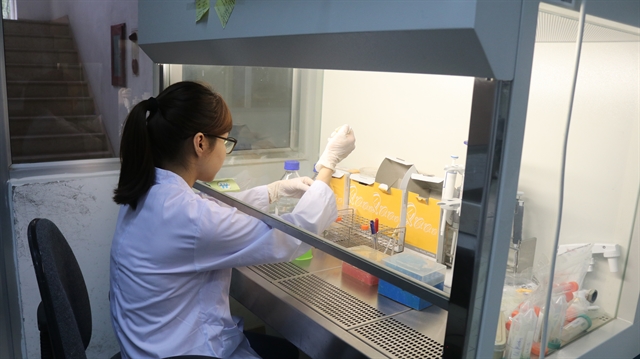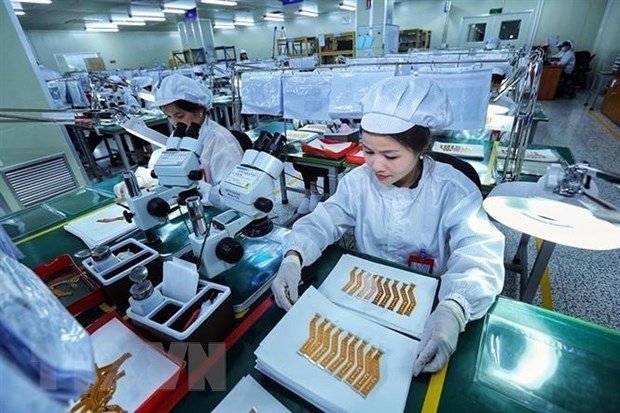 Society
Society

Dr Phạm Doãn Lân, deputy head of the National Institute of Animal Sciences under the Ministry of Agriculture and Rural Development talks with Vân Nguyễn & Minh Phương on the importance and prospects of this cloning technology.

|
| Dr Phạm Doãn Lân, deputy head of the National Institute of Animal Sciences. — VNS Photo Minh Phương |
Việt Nam has for the first time successfully cloned pigs using the somatic cells from ear tissue. Four healthy piglets were born in March. This is an important breakthrough for the country’s animal cloning sector, proving its science and technology’s role and position in the region and the world.
Dr Phạm Doãn Lân, deputy head of the National Institute of Animal Sciences under the Ministry of Agriculture and Rural Development talks with Vân Nguyễn & Minh Phương on the importance and prospects of this cloning technology.
Could you tell us about your work and why the pot-bellied pig was selected for this project?
A total of four cloned pigs were born on March 10 weighing 300g each. They are 1-1.5 kg each now with typical characteristics of a pot-bellied pig including small erect ears, a swayed back, a pronounced potbelly and a straight tail. Our pigs are healthy and have grown normally compared to normal pigs of the same breed. This is a good sign and we are still closely following the progress of the pigs.
Currently, Việt Nam has more than 20 domestic pig breeds, which often yield low economic values compared to foreign breeds. Pot-bellied pig is a traditional Vietnamese domestic breed that was once neglected due to lower economic value compared to imported breeds. In 2016-2017, Minister of Agriculture and Rural Development Nguyễn Xuân Cường wanted to preserve this breed for its genetic values and high quality.
Conservation of native animal genetic resources is very important to biodiversity. Without conservation, some declining species can’t recover their population and can disappear. This is also important for hybridisation. So that’s why this is selected for this project.
How has animal cloning been studied in Việt Nam?
The world’s first successful cloning technology on sheep was announced in 1996.
Vietnamese scientists have also done studies on this technology, for example the International University under Việt Nam National University HCM City and Institute of Biotechnology under the Việt Nam Academy of Science and Technology have studied cloning on cattle like cows and pigs but they have just announced to have successfully produced cloned embryo.
This is the first time Việt Nam successfully cloned a pig. It has been more than 20 years since the sheep Dolly was made and many breakthroughs in science and technology have been made but with limited resources, our achievement in pig cloning proves the capacity of our scientists. And as far as I know, in ASEAN, Việt Nam only ranks second after Thailand in animal cloning.

|
| A scientist works in a laboratory of the National Institute of Animal Sciences. — VNS Photo Minh Phương |
Why is this so important and what are the research prospects for Vietnamese scientists following the success of this project?
The somatic cell nuclear transfer technology was successfully carried out for the first time in 1996 in the UK, where scientists created Dolly the sheep. This successful cloning technology opened a path for many studies in biology, medicine and fertility.
Pig cloning technology in Việt Nam can be used in preserving rare and endangered native species, choosing animal breeds that have good genetic potentials or of high quality. For example, we can use the cloning technology to produce an exact genetic copy of a high quality cow with good economic values. International scientists are also aiming towards genetic engineering to transfer beneficial genes, say disease resistance or high fertility rate, from one to another.
In the long term, this technology can help to create cloned pigs for organ transplants for humans. Research showed pig organ transplants in humans are promising.
Depending on each country, this will open different paths for further studies.
We hope to receive further support from the government and the Ministry of Agriculture and Rural Development to conduct studies on other breeds as well as to evaluate the fertility and growth capacity of cloned pigs.
Genetically modified products are still controversial. How do you view concerns over this issue?
Countries have different views on gene engineering, however it is necessary to do research on this for scientific purposes because this can open up many important findings in many fields. Nowadays, there are advanced technologies that allow precise gene engineering.
Many countries including the US and China are very open with genetically modified products. GM foods like corn or soya beans are very popular. However, there are big differences between plants and animals that we need to consider carefully.
What are the main difficulties scientists faced during the project?
Our project started in July 2017. Our scientists worked around the clock for this project. Many procedures, such as embryo transfer, require precise timing. We also had failures and had to repeat many steps over and over again. Sometimes we almost made it but the pig died when we almost got there.
Lack of equipment is a major challenge in this project. We also have difficulties in attracting young scientists. Low salary and hard work make this less attractive to graduates. Meanwhile they have many other options including working for companies that offer two to three times income compared to working here.
The success of this cloning technology with limited resources makes us very proud. — VNS









